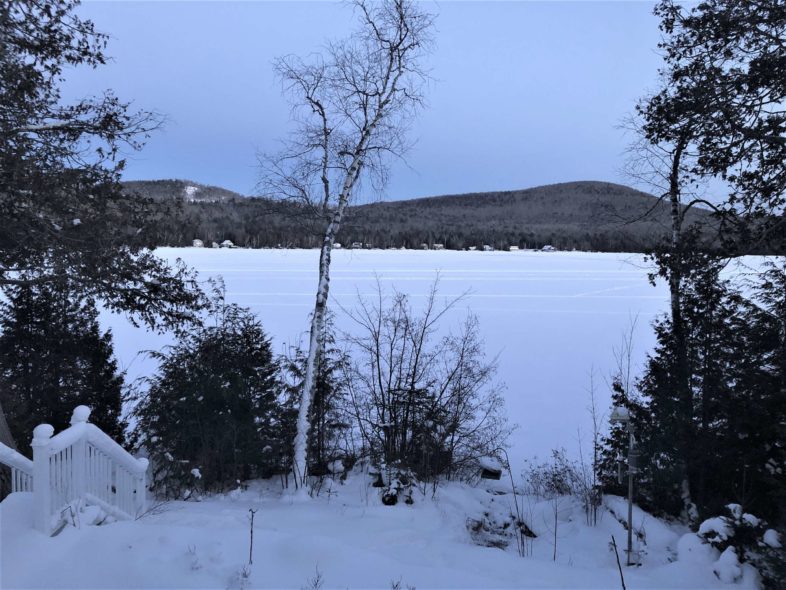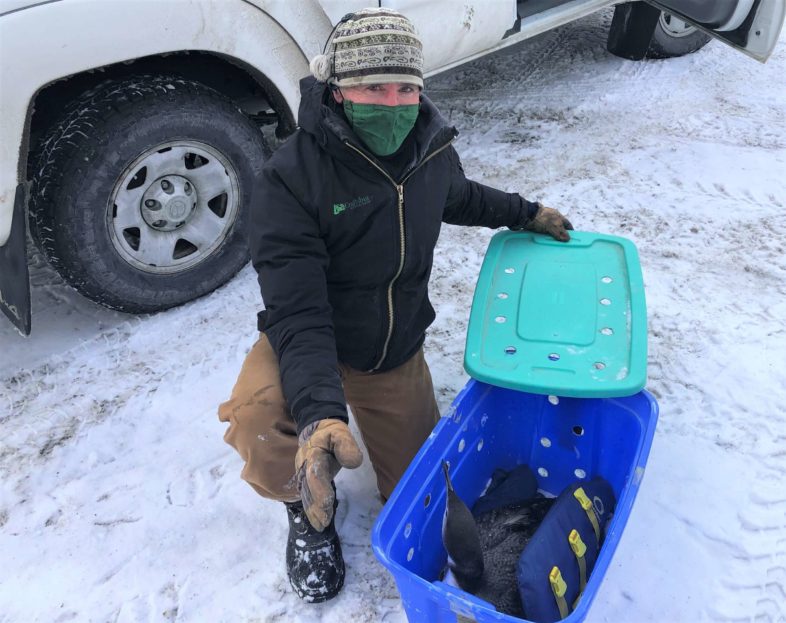On January 28th, I received an email from Chris and Mary von Alt about a loon in distress on snow- and ice-covered Maidstone Lake in Vermont’s Northeast Kingdom. You may be wondering–and rightly so–”What the heck is a loon doing on Maidstone in January?” We’re not exactly sure where the loon came from, but somehow it ended up on the lake in front of their house.
The von Alts are active members of the Maidstone Lake Association and newly-minted Vermont Loon Conservation Project volunteers. After learning about the need for Adopt-a-Lake volunteers on Maidstone, they enthusiastically agreed to help monitor the three territorial loon pairs expected to arrive this summer. It appears that their “tour of duty” has started early! Read on for Chris and Mary’s riveting account of this ice-stranded loon rescue.

Maidstone Lake in January © Chris von Alt
A Loon Rescue in January on Maidstone Lake
Chris & Mary von Alt
January 31, 2021
It was mid-afternoon, an overcast day in late January near 0°F, as I stood at the window looking out at a frozen, snow-covered Maidstone Lake. Movement caught my eye. “That looks like a mink loping across the middle of the lake,” I said to my wife and pandemic partner. I grabbed our binoculars and as I focused in, I saw the animal kick its foot out as I’ve seen loons do so often. “We have a loon stranded on the lake, there is no way it can take off.” Questions began to pop up: How did it arrive on the lake? Was it sick? Will it die? Is there any way to help it? Just then, as the wind picked up from the west, the bird made a gallant effort to get into the sky by flapping its wings as it struggled to race across the snow-covered lake for a couple hundred feet. Then it stopped, just off the shore in front of our home.
We turned to each other asking, how are we going to save this loon?
We know that loons don’t mind the cold, and that they can go for long periods without eating. Sometimes they will inhabit open streams at the outflows of lakes late into the winter, until they are motivated by a predator or hunger to move on, but stuck without a path to the sky. A neighbor told us that five days earlier a loon had been spotted flying, then landing on the lake. However it happened, there was an apparently healthy loon stuck on Maidstone Lake, with no food and no way to get back in the air, and we wanted to save it.
Calls, emails, and text messages went out to the local Game Warden, to the leadership of the Nulhegan Basin Wildlife Refuge, to the Maine Loon Project, and to the Vermont Center for Ecostudies, looking for answers and help, but with no immediate success. As night settled in, we talked to the refuge biologist about going out ourselves to rescue the bird, but decided against it, because we had no idea how to hold it or what to do with it if we captured it. In the end, we decided the bird stood a better chance staying where it was until we could get someone competent to help it. We spent a restless night, wondering if the bird would live through the night at subzero temperatures.
Morning came and brought success. Not only was the bird alive, looking around, and still resting in the same spot on the ice-covered lake, but two of the people contacted the day before had reached Eric Hanson of the Vermont Center for Ecostudies, a loon expert. Late Friday morning, Eric phoned. As soon as he finished work around noon at the Craftsbury Outdoor Center (his winter employer), he would drive over to rescue the loon.
Eric came equipped with a net and a plastic box with air holes in it to transport the bird. He put on a pair of snowshoes and set out across the lake, returning in short order with the bird comfortably nestled in the box on top of a life preserver, which would protect its underbelly and breast, something we would never have thought of.

Eric Hanson preparing to transport the rescued loon to open water. © Chris von Alt
The loon was a relatively small adult, said Eric, likely from mid to northern Quebec, coming through this area while migrating. Loons that breed in the interior of North America are smaller than those from Vermont, Maine, or Nova Scotia, where a male can grow to be 12-16 pounds. A Minnesota or Manitoba male loon might weigh 8-10 pounds. Females weigh two to three pounds less from each region. Other than size, it’s hard to tell the difference between a male and female loon. After a short chat, Eric set off on the three-hour drive to open water at the Burlington harbor on Lake Champlain. Releasing the loon into the lake, Eric said it flapped its wings over and over to re-align its feathers for waterproofing, called out to the winter sky, and then dove–something that is always amazing to watch.
Eric concluded in an email: “I always wonder what they are thinking about being stuck in the snow for days, then being stuck in a warm box for hours, then finally returning to water and normalcy. Thanks so much for all your help and tracking me down. Thanks to Rachel (the Refuge biologist) for offering to go out there. I knew if we got the bird, it’d still involve transport, thus my rush to come over right away.”
Now the bird is back in open water where the fishing is good and the living a bit easier. That makes us all feel better. Please help support the Vermont Center for Ecostudies, so more great outcomes are possible.
P.S. Ten days after this rescue, I received a phone call from Bren Lundorg at the Vermont Institute of Natural Science (VINS) Center for Wild Bird Rehabilitation about a loon found on a homeowner’s driveway near Brattleboro. The bird was in good shape and ready to be released, so I made the trip from Craftsbury to Quechee to retrieve the loon, then drove it to Burlington for release on Lake Champlain. One can’t help but wonder about how individual loons manage to get themselves into predicaments like this every winter!

I love this story SO MUCH. Here in NYC, we have the partnership of the Wild Bird Fund and NYC Audubon so that when someone finds a bird in trouble, he or she can find someone to help. But we don’t have loons on frozen lakes. The partnership (and expertise) is just great!
Great work by all involved!
Awesome story, happy ending. Thank you Eric. A Loon biologist’s work is never done, even in the winter months.
Excellent work by all, especially Eric for driving the loon all the way to open water in Burlington. Loons are so magnificent in their markings.
Eric, is a loonatic and does such good work…..loved this story…..
Lovely story, but can anyone tell me why the loon was unable to fly? I guess I don’t know enough about loons.
hi veronica, Loons usually need 1/4 mile of open water to take-off and prefer longer stretches so that while they are 2 feet off the surface, would rather have water under them than land. This loon likely got stuck in an open water hole but we don’t know whether it was on the lake or just over the dam at the outlet where flowing water kept it open. When temps finally dropped, the hole it was in likely started freezing in so it made a move and ended up on the ice. Loons cannot take off from solid surfaces. It would wing row pushing itself around the frozen lake surface but never really got anywhere. Luckily, local residents saw it and called me. hope that helps. eric hanson
This is a wonderful story. I’m sure Eric has many, many other happy ending stories. Wouldn’t it be good medicine for us all to read one every day during the pandemic?!
Eric, Thanks for all that you do for the loons in our State. We stay at a family camp on Little Hosmer, and every September-October, it seems that the baby is always left behind on the lake. I don’t know when it leaves, but often wonder if it gets stuck there? It’s nice to know that there is someone to call or reach out to. Thank you for your compassion to save our beautiful birds. Best wishes to you!
Hi Audrey, We need to connect as I live down the road from L. Hosmer. Adults leave first leaving the chicks to figure the migration thing out for themselves. Most do it well. But there can be those stragglers that take a little longer or a little help. thanks for your note. eric